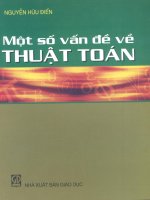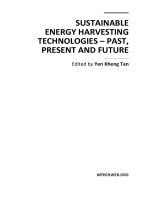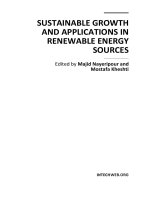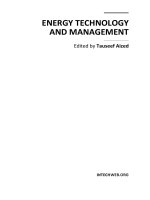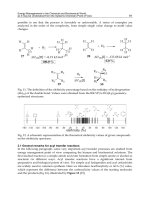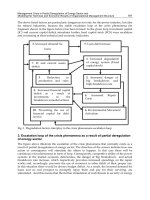Wind Energy Management Part 1 pot
Bạn đang xem bản rút gọn của tài liệu. Xem và tải ngay bản đầy đủ của tài liệu tại đây (403.01 KB, 13 trang )
WIND ENERGY
MANAGEMENT
Edited by Paritosh Bhattacharya
Wind Energy Management
Edited by Paritosh Bhattacharya
Published by InTech
Janeza Trdine 9, 51000 Rijeka, Croatia
Copyright © 2011 InTech
All chapters are Open Access articles distributed under the Creative Commons
Non Commercial Share Alike Attribution 3.0 license, which permits to copy,
distribute, transmit, and adapt the work in any medium, so long as the original
work is properly cited. After this work has been published by InTech, authors
have the right to republish it, in whole or part, in any publication of which they
are the author, and to make other personal use of the work. Any republication,
referencing or personal use of the work must explicitly identify the original source.
Statements and opinions expressed in the chapters are these of the individual contributors
and not necessarily those of the editors or publisher. No responsibility is accepted
for the accuracy of information contained in the published articles. The publisher
assumes no responsibility for any damage or injury to persons or property arising out
of the use of any materials, instructions, methods or ideas contained in the book.
Publishing Process Manager Romina Krebel
Technical Editor Teodora Smiljanic
Cover Designer Jan Hyrat
Image Copyright Sander van der Werf, 2010. Used under license from Shutterstock.com
First published July, 2011
Printed in Croatia
A free online edition of this book is available at www.intechopen.com
Additional hard copies can be obtained from
Wind Energy Management, Edited by Paritosh Bhattacharya
p. cm.
ISBN 978-953-307-336-1
free online editions of InTech
Books and Journals can be found at
www.intechopen.com
Contents
Preface VII
Part 1 Weibull Distribution and Its Analysis 1
Chapter 1 Weibull Distribution for Estimating the Parameters 3
Paritosh Bhattacharya
Part 2 Environmental Hydrolics 13
Chapter 2 Optimizing Habitat Models as a Means
for Resolving Environmental Barriers for Wind Farm
Developments in the Marine Environment 15
Henrik Skov
Part 3 Power System Control 31
Chapter 3 Technical Framework Conditions to Integrate High
Intermittent Renewable Energy Feed-in in Germany 33
Harald Weber, Christian Ziems
and Sebastian Meinke
Part 4 Wind Farm Analysis 61
Chapter 4 The Design and Implement of Wind Fans
Remote Monitoring and Fault Predicting System 63
Yao Wanye and Yin Shi
Part 5 Wind Turbine Generators 85
Chapter 5 Superconducting Devices in Wind Farm 87
Xiaohang Li
Chapter 6 Modeling and Designing a Deadbeat Power Control
for Doubly-Fed Induction Generator 113
Alfeu J. Sguarezi Filho and Ernesto Ruppert
Preface
Wind energy is one of the most prominent renewable energy sources today. The
increasing concerns with environmental issues are driving the search for more
sustainable electrical sources. Wind energy along with solar energy, biomass and wave
energy are possible solutions for environmentally friendly energy production. The
initialization of wind power installation, which started in the beginning of 1980s, is
very much related to the oil crises of the mid 1970s. During the 1980s, most wind
power installations were limited to a few hundred kilowatts. The small size of those
installations did not threaten the power system stability. The 1990s marked an
important breakthrough in the industry. New concepts emerged because of the
demand for more efficient power production and because of the necessity to comply
with power quality requirements. During the 1990s, wind turbines grew in size and
production, from just a few hundred kilowatts to megawatts. This book focuses on
Weibull Distributioin, Environmental hydraulics, power system control, wind turbine
generators etc.
The successful completion of this book has been the result of the co-operation and
input by numerous people. I wish to both acknowledge and express my gratitude to
all of them.
Since the inception of this work to its final stages, I have been privileged to find
guidance, support and strength from Prof. (Dr.) P.K.Bose, Director, National Institute
of Technology, Agartala, Tripura and Prof. (Dr.) B.B. Ghosh, Ex-Professor, Indian
Institute of Technology, Kharagpur who are highly distinguished personalities in their
own field. I feel highly indebted and find a great pleasure in expressing my deep sense
of gratitude to both of them.
I am thankful to our publishers InTech for the painstaking efforts and cooperation in
bringing out this book in a short span of time.
VIII Preface
Finally, I am also thankful to all my well wishers and friends who encouraged me
directly or indirectly for this work. My life long thanks to my wife Mrs. Indrani, my
son Priyotosh, who bear with me in my good and worst period of my life.
Dr. Paritosh Bhattacharya
Department of Mathematics
College of Engineering & Management
Kolaghat, India
Part 1
Weibull Distribution and Its Analysis
1
Weibull Distribution for
Estimating the Parameters
Paritosh Bhattacharya
Department of Mathematics, College of Engineering & Management, Kolaghat
India
1. Introduction
Today, most electrical energy is generated by burning huge fossil fuels and special weather
conditions such as acid rain and snow, climate change, urban smog, regional haze, several
tornados, etc., have happened around the whole world. It is now clear that the installation of
a number of wind turbine generators can effectively reduce environmental pollution, fossil
fuel consumption, and the costs of overall electricity generation. Although wind is only an
intermittent source of energy, it represents a reliable energy resource from a long-term
energy policy viewpoint. Among various renewable energy resources, wind power energy
is one of the most popular and promising energy resources in the whole world today. At a
specific wind farm, the available electricity generated by a wind power generation system
depends on mean wind speed (MWS), standard deviation of wind speed, and the location of
installation. Since year-to-year variation on annual MWS is hard to predict, wind speed
variations during a year can be well characterized in terms of a probability distribution
function (pdf). This paper also addresses the relations among MWS, its standard deviation,
and two important parameters of Weibull distribution.
The wind resource varies with of the day and the season of the year and even some extent
from year to year. Wind energy has inherent variances and hence it has been expressed by
distribution functions. In this paper, we present some methods for estimating Weibull
parameters, namely, shape parameter ( k ) and scale parameter ( c ). The Weibul distribution
is an important distribution especially for reliability and maintainability analysis. The
suitable values for both shape parameter and scale parameters of Weibull distribution are
important for selecting locations of installing wind turbine generators. The scale parameter
of Weibull distribution also important to determine whether a wind farm is good or not. The
presented method is the analytical methods and computational experiments on the
presented methods are reported.
2. Weibull distribution
The Weibull distribution is characterized by two parameters, one is the shape parameter k
(dimensionless) and the other is the scale parameter c (m/s)
The cumulative distribution function is given by
() 1 exp
k
v
Fv
c
é
ù
æö
ê
ú
÷
ç
=- -
÷
ç
ê
ú
÷
÷
ç
èø
ê
ú
ë
û
(1)

